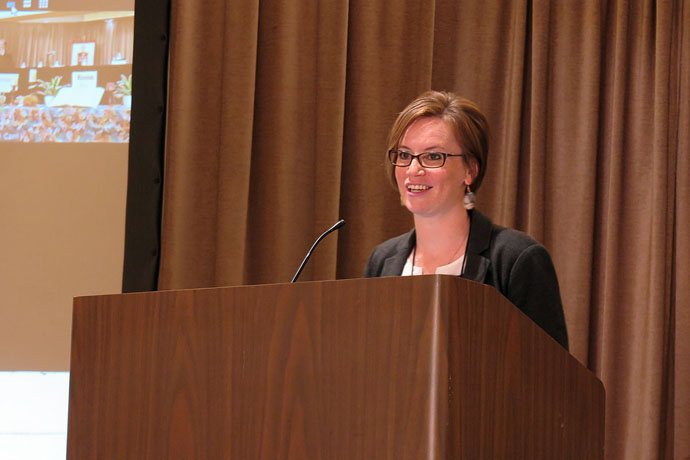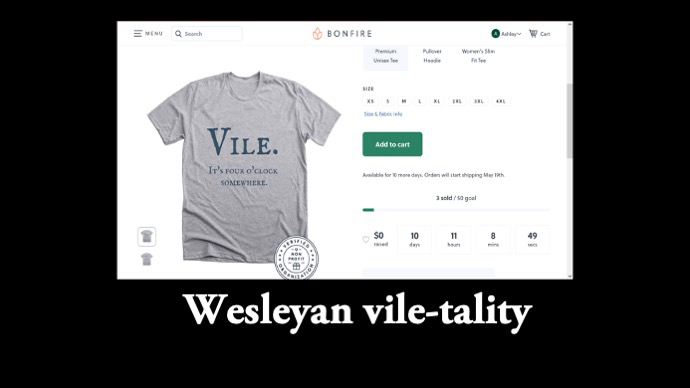Key Points:
- Ashley Boggan, a United Methodist historian and agency top executive, challenged bishops to learn from history to work toward a brighter future.
- She noted that the challenges John Wesley faced are not all that dissimilar from what The United Methodist Church faces today.
- She pointed to how Wesley took risks to reach people in his day, submitting to be “more vile” by preaching outdoors.
- That Wesleyan example of “vile-tality” could be what church leaders need today, Boggan said.
John Wesley was no fan of the title “bishop.”
“How can you, how dare you suffer yourself to be called Bishop?” Methodism’s founder wrote to Bishop Francis Asbury in 1788. “I shudder, I startle at the very thought! Men may call me a knave or a fool, a rascal, a scoundrel, and I am content; but they shall never by my consent call me Bishop!”
Historian Ashley Boggan admitted that whenever she reads Wesley’s blistering words, “I still feel like I’m in trouble.”
It was the last letter Wesley in England sent across the Atlantic to Asbury, a crucial organizer and one of the first two bishops in the newly established Methodist Episcopal Church in the U.S.
The new denomination that Asbury helped form would eventually develop into today’s United Methodist Church, which still has 59 bishops in active service across four continents. But it also is a denomination with plenty of troubles, including a mounting number of church disaffiliations after decades of debate over LGBTQ inclusion.

Boggan, top executive of the United Methodist Commission on Archives and History, challenged the Council of Bishops during the group’s recent in-person meeting to use the church’s past to envision a brighter future.
Her presentation was part of the bishops’ long-term efforts to rethink the role of the episcopacy amid the denomination’s financial constraints and changing landscape.
Boggan suggested the bishops release some of Asbury’s formality and renew Wesley’s rascally adaptability in spreading scriptural holiness.
“Once we became established as a mainline denomination, we lost our willingness to be proactive, provocative and prophetic, and became merely reactive to organizational and ecclesial needs,” she said.
“I want to propose some ways in which we might reclaim our Wesleyan heritage of prophetic vision, mission and ministry.”
That starts with recognizing that Asbury had reason to pivot away from the wishes of the aging Wesley, who had little understanding of the sensibilities of the new nation where Asbury ministered.
Boggan pointed out that Asbury was building an institution, while Wesley was leading a movement. Asbury and other bishops’ institution-building was critical to the spread of Methodism — and its form of Christian discipleship — across the burgeoning United States.
Over its first 150 years, that institution grew and Methodism in the U.S. saw significant changes, including a split over slavery in 1844.
Subscribe to our
e-newsletter
However, Boggan argued that it was the creation of the jurisdictional system for electing bishops in 1939 — with its segregated Central Jurisdiction — that put a full stop to any semblance of the prophetic mission of the Methodist tradition.
“It was through this system that Methodism institutionally and broadly catered to white supremacy,” she said.
The Central Jurisdiction officially ended with the formation of The United Methodist Church in 1968. But Boggan said the denomination’s current jurisdictional and central conference system has brought its own problems.
Today, amid growing distrust of institutions and rising numbers with no religious home, Boggan encouraged United Methodist leaders to take a page out of Wesley’s playbook.
“Y’all, The United Methodist Church is an institution in need of some movement,” she said.
John Wesley’s 18th-century mission field of rapidly industrializing Britain was not that dissimilar from the United States of today, with its own near-constant technological changes and highly mobile populace alienated from church life.
“Many of the people in the 18th century were ‘nones’ and ‘dones,’” Boggan said. “They were tired of the institutional church because it did not meet their everyday needs, and it refused to change in order to do so.”
But Wesley himself was willing to change, at least after some reflection and prayer. When his friend George Whitefield invited him to the teeming seaport city of Bristol, England, Wesley was astonished to find Whitefield preaching to thousands outside in the fields.
Less than a century after Puritan field preaching had helped inflame the bloody English civil wars, Wesley thought the saving of souls “almost a sin if it had not been done in a church.”
However, two days after his arrival, Wesley chose to follow Whitefield’s example.
“At four in the afternoon, I submitted ‘to be more vile’ and proclaimed in the highways the glad tidings of salvation,” Wesley wrote in his journal on April 2, 1739. That day, he preached to 3,000 people about Luke 4:18-19.
Field preaching became a key way that Wesley and others in his nascent movement preached “good news to the poor,” proclaimed “release to the captive” and promoted Christian revival.
Wesley’s ministry was not just bucking convention. By preaching in a diocese that was not his own, Boggan said, Wesley directly and openly violated the church law of his day.
Still, Wesley’s transgressive commitment to mission continues to inspire. Boggan recounted how some United Methodist young adults in Tennessee were so captivated by Wesley’s daring that they designed T-shirts that said “Vile. It’s Four O’Clock Somewhere.”
“If we want to be vital again, if we want to reach young people in new ways, if we want to pivot and reclaim, revive and renew our sense of Wesleyan mission in this world — perhaps we first need to submit to be more vile,” Boggan said.

In today’s context, she said, that could mean looking for opportunities to engage more people online and getting beyond the usual Sunday worship schedule. She noted that the physical act of going to church on a Sunday morning doesn’t always align with people’s needs.
She used the example of her sister’s family — where both parents have full-time jobs; both kids have a host of school and weekend activities; and the time to just be together as a family is rare. During the pandemic, the family got in the habit of spending Sundays in a boat on a nearby lake. Boggan said her younger nephew named the boat, “Better Than Church.”
“My sister is one of many, including myself, who is looking for new ways to do church,” Boggan said.
“Wesley was not reaching persons sitting in the pews on Sunday morning. He was reaching people, connecting with them and connecting them to each other and to God, where they were — which was outside of the church on a Sunday morning.”
Bishop LaTrelle Easterling, who leads the Baltimore-Washington and Peninsula-Delaware conferences, said Boggan gave the bishops some important things on which to ponder.
“Some people will wrestle with the term ‘vile,’” Easterling acknowledged. But she sees it as a call to be subversive in the same way Christ was subversive.
“Christ was subversive to those oppressive forces that were privileging some at the expense of others,” Easterling said. “I think she calls us back to that kind of theology, that kind of advocacy, that kind of bold, innovative action.”
Upper New York Conference Bishop Héctor A. Burgos-Núñez said that going forward, bishops today should work to be facilitators of relationships and conversations that reveal where God is guiding the church.
“What is the leadership that we need at this time?” he said. “I think it will require us to create spaces for deep listening so God’s vision can come out in the hopes and the aspirations of the people.”
Boggan told the bishops that United Methodists must start to do church differently.
“Our job here is not to set up The United Methodist Church for today or even tomorrow,” she said. “It’s our job to set up The United Methodist Church for 100 years from now. … In 100 years, I don’t want future generations to think, ‘Wow, 2023, they really had a shot if only they would have taken it.’”
Hahn is assistant news editor for UM News. Contact her at (615) 742-5470 or newsdesk@umnews.org. To read more United Methodist news, subscribe to the free Daily or Friday Digests.




